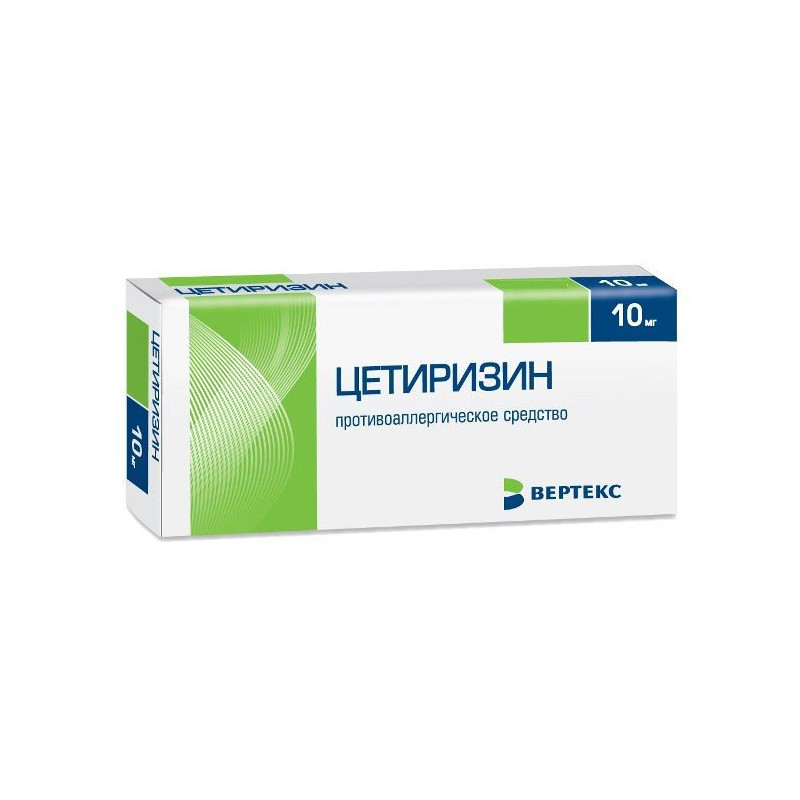



 All payments are encrypted via SSL
All payments are encrypted via SSL
 Full Refund if you haven't received your order
Full Refund if you haven't received your order
Cetirizine
cetirizine
film pills
One pill contains:
Active substance: cetirizine dihydrochloride 0.01 g.
Auxiliary substances: microcrystalline cellulose - 0.034 g, lactose monohydrate - 0.07 g, crospovidone - 0.0036 g, Magnesium stearate - 0.0012 g, colloidal silicon dioxide (aerosil) - 0.0012 g.
Shell: [hypromellose, talc, titanium dioxide, macrogol 4000 (polyethylene glycol 4000)] or [dry white film cover containing hypromellose, talc, titanium dioxide, macrogol 4000] - 0.004 g.
Round, biconvex tablets, film-coated white or almost white. In the cross section, the core is white or almost white.
Pharmacotherapeutic group: antiallergic agent, H1-histamine receptor blocker.
Pharmacodynamics
A competitive histamine antagonist, a hydroxyzine metabolite, blocks H1-histamine-new receptors. Prevents the development and facilitates the course of allergic reactions, has antipruritic and anti-exudative action. Affects the early stage of allergic reactions, limits the release of inflammatory mediators at the "late" stage of an allergic reaction,reduces the migration of eosinophils, neutrophils and basophils. Reduces capillary permeability, prevents the development of tissue edema, relieves spasm of smooth muscles.
Eliminates skin reactions to the introduction of histamine, specific allergens, as well as cooling (with cold urticaria).
Practically no anticholinergic and antiserotonin action.
In therapeutic doses, practically does not cause a sedative effect.
Onset of action after a single dose of 10 mg of cetirizine - after 20 minutes (in 50% of patients) and after 60 minutes (in 95% of patients) lasts more than 24 hours. Against the background of a course treatment, tolerance to the antihistamine effect of cetirizine does not develop. After cessation of treatment, the effect lasts up to 3 days.
Rapidly absorbed from the gastrointestinal tract, the time to reach maximum concentration after oral administration - 1 hour. Food does not affect the completeness of absorption (AUC), but lengthens the time to reach maximum concentration by 1 hour and reduces the maximum concentration by 23%. When taken in a dose of 10 mg once a day for 10 days, the equilibrium concentration in plasma is 310 ng / ml and is noted 0.5-1.5 hours after administration. Communication with plasma proteins - 93% and does not change when the concentration of cetirizine in the range of 25-1000 ng / ml. The pharmacokinetic parameters of cetirizine change linearly with its appointment in a dose of 5-60 mg. Volume of distribution - 0.5 l / kg.
It is metabolized in small quantities in the liver by O-dealkylation with the formation of a pharmacologically inactive metabolite (unlike other H1-histamine receptor blockers,metabolized in the liver with the cytochrome P450 system). Does not accumulate. 2/3 of the drug is excreted unchanged by the kidneys and about 10% through the intestines.
Systemic clearance - 53 ml / min. The elimination half-life in adults is 7-10 hours, in children 6–12 years old - 6 hours, in children 2–6 years old - 5 hours, in children from 6 months to 2 years - 3 hours. In elderly patients, the half-life increases by 50 %, systemic clearance is reduced by 40% (reduced kidney function).
In patients with impaired renal function (creatinine clearance below 40 ml / min), the clearance of the drug is reduced, and the half-life is extended (for example, in patients on hemodialysis, the total clearance is reduced by 70% and is 0.3 ml / min / kg, and the half-life is extended by 3 times), which requires a corresponding change in dosing regimen.
In patients with chronic liver diseases (hepatocellular, cholestatic or biliary cirrhosis), the elimination half-life is 50% and the total clearance is reduced by 40% (correction of the dosing regimen is required only with a concomitant decrease in glomerular filtration rate).
Penetrates into breast milk.
Seasonal and perennial allergic rhinitis and conjunctivitis (itching, sneezing, rhinorrhea, lacrimation, conjunctival hyperemia), urticaria (including chronic idiopathic urticaria), hay fever (pollinosis), itching, angioedema (Quincke's edema), allergic pruritic dermatoses.
Hypersensitivity to cetirizine, other components of the drug, hydroxyzine, reduced kidney function (creatinine clearance 30-49 ml / min), chronic renal failure, children under 6 years old, pregnancy, lactation period.
Older age (possibly reduced glomerular filtration).
The use of the drug during pregnancy is not recommended. Since cetirizine penetrates into breast milk, it is not prescribed during breastfeeding.
Inside, regardless of the meal, not chewing and drinking plenty of fluids, preferably in the evening.
Adults and children over the age of 6 years (with a body weight of more than 30 kg) - 1 pill once a day.
The drug is usually well tolerated. Side effects are rare and have a transient nature.
On the part of the digestive system: dry mouth, dyspepsia.
Nervous system disorders: dizziness, headache, drowsiness, fatigue, agitation, migraine.
Allergic reactions: angioedema, skin rashes, itching, urticaria.
Symptoms (when taking a single dose of 50 mg): dry mouth, drowsiness, urinary retention, constipation, anxiety, irritability.
Treatment: gastric lavage, symptomatic therapy. The specific antidote is not revealed. Hemodialysis is ineffective.
Interaction with other drugs
Combined use with theophylline (400 mg / day) leads to a decrease in the total clearance of cetirizine (the kinetics of theophylline does not change).
Myelotoxic drugs increase the hematoxicity of the drug.
No clinically significant interactions with other drugs (pseudoephedrine, cimetidine, Ketoconazole, Erythromycin, Azithromycin, diazepam, glipizide) were detected.
Simultaneous consumption with alcohol and drugs depressing the central nervous system is not recommended.
Impact on the management of vehicles and mechanisms
During the period of treatment, it is necessary to refrain from practicing potentially hazardous activities that require increased concentration of attention and quickness of psychomotor reactions. If you exceed the dose of 10 mg / day, the ability for rapid reactions may deteriorate.
In a dry, dark place at a temperature not higher than 25 ºС.
Keep out of the reach of children.
Shelf life: 2 years. Do not use after expiration date.
Pharmacy sales terms: No prescription.
